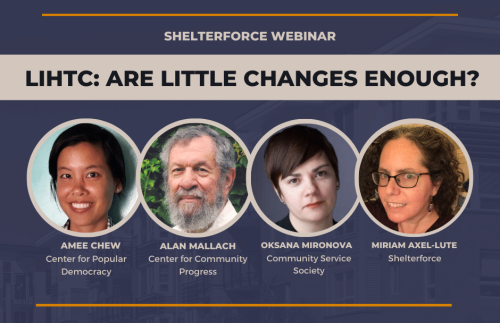Harold Simon: How about the HFAs? How can they be deployed in this?
Raphael Bostic: I think the HFAs are incredibly important. And to the extent that we can have them be our laboratories for experimentation, there’s a lot to be learned in a relatively short period of time. I think they have been underappreciated as a potential partner, and we’ve started reaching out and having much more intensive conversations with them. They’re trying stuff, and it would be good to probably have more conversation with them to understand which of their experiments and innovations they believe have yielded the biggest benefits.
Alan Mallach: I think it’s quite possible that, with some relatively small tweaks to tax laws and other things, the HFAs could become even more effective producers of capital for multifamily lending. But at the same time, they’re not retail outlets, so they would need to partner with retail outlets to make this capital accessible to the small multi-family sector.
Jeff Lubell: But they already do that in their single-family business.
Alan Mallach: No. They typically work through banks. They’re not direct lenders, typically.
Jeff Lubell: But banks wouldn’t be bad conduits for reaching out to small property owners.
Alan Mallach: It’s possible. Especially some of the community banks that actually have relationships and familiarity with local markets.
Jeff Lubell: Banks are already doing what lending exists in that space. So that’s where a lot of the expertise already resides, but they don’t have necessarily the capital capacity to take a lot of those on their books.
Alan Mallach: Yes, if you created the legal and tax structure to make it possible or easier for HFAs to create small multi-lending processes that would go through retail intermediaries. Typically HFAs do their single-family lending through retail intermediaries, but they do their multifamily lending directly and typically on large-scale projects only.
Raphael Bostic: Part of the challenge is to make sure that we’re clear on what the goals and the objectives of the investments are. With HFAs, sometimes they can be a bit more passive on that, and there may be more of a responsibility on our side, as federal policymakers, to provide clearer guidance on what success looks like. I know there are a number of states where people have been dissatisfied with the distribution of some state HFA activity. And in part, I think it stems from lack of clarity or a difference of opinion about what it is we’re trying to accomplish through these investments.
Alan Mallach: There are many HFAs out there, and they each have very different agendas, and they’re each subject to very different state-level political influences. So I think having more direction at the federal level would probably be valuable.
Miriam Axel-Lute: We started off talking about the different needs of hot markets and cold markets, which is what got us into some of this great conversation about existing stock. Thinking about the tools that we have right now and the data that we have, how do we tweak things so that the right sorts of housing assistance are going to the areas with the different sorts of markets? How do we differentiate programs based on the local conditions?
Alan Mallach: In a lot of programs there’s a lot of flexibility at the local level. Like with CDBG and HOME, they’re locally determined, but you have political pressures working to direct the money in directions that may not be the most productive from a rational housing standpoint.
I’ve found that the amount of CDBG and HOME money that goes into private market rental housing is tiny compared to the amount that goes to assist homeowners in various fashions, and that obviously reflects the greater political desirability of working with homeowners.
When you look at something like the tax credit program, that’s where I think it’s really important to restructure the program so there is the flexibility in a place like Ohio, or Michigan, or Nevada to use those resources in ways that deal with the existing stock with the private market rental stock and things like that, that are currently in some cases not possible, and in other cases possible, but very difficult.
Raphael Bostic: Alan, you’re actually talking about two different things that intersect. One is the question of are certain activities allowed, or is there a bias towards or away from a type of activity. There are going to be a series of policies where you want to make sure that the set of allowable activities is broad enough. But the second point that you alluded to is actually a more interesting one. So in the CDBG case, there’s nothing that prevents communities from doing things. They’re just choosing not to do them. And the question is how do you get those issues more prominent in people’s collective psyche so they understand the implications of choosing not to do things that ultimately can have a real positive benefit.
And that’s the hard part, and that to me is why we just need to be much more assertive. I mean, this administration has tried very much to talk about a balanced housing policy where rental is on a par with ownership and get that much more into the public decision-making psyche.
Alan Mallach: Yes. It’s a delicate balance because, on the one hand, the locals prize CDBG at least partly because HUD doesn’t tell them exactly what to do with the money. And as a result, I think in many cities, CDBG has become what I think of as a sort of benign political patronage.
Chris Herbert: Part of the decision-making also will reflect how much money is available, and if you’re going to devote it to rental housing, are you going to devote the lion’s share of it in order to accomplish something.
And also, what are the resources you have? So if you have the HOME program that’s restricted to housing alone, then CDBG’s going to go to the things that HOME doesn’t cover. So you have to look at those things in their totality.
It does seem like [with] the low-income housing tax credit, if you brought the goals from just providing affordable housing generally to along the lines of the issues that Jeff was talking about at the beginning about making sure that we’re preserving affordable housing in key locations, that those investments are probably needed in lots of market areas. Whether or not generally affordable housing is needed, well-located affordable housing is needed, and also investments that can serve as a catalyst for neighborhood revitalization.
It does seem like the fact that the low-income housing tax credit is broadly distributed around the country is an important factor in having political support, which is something that you really can’t ignore. So broadening the goals of the program beyond purely adding to the affordable stock is one way to make sure that the programs are providing public benefit.
Raphael Bostic: I would throw out CRA as another area where this could be very important. Most of the banks I’ve talked to, when they think about CRA, think new construction, major investments, and those sorts of things. Adding preservation as an important source of fulfilling that responsibility would be very helpful.
Alan Mallach: Yes. Preservation and upgrading the existing stock, private stock, as well.
Raphael Bostic: Yes, exactly right.
Jeff Lubell: I just want to make sure that we focused on the tension between all of the ambitious policy goals that we’ve been talking about and the diminished capacity at the local level to actually administer these programs and analyze their situation and develop appropriate solutions.
A lot of important housing policy decisions get made at the local and state levels. All the issues around supply and density and parking requirements and tax increment policies and inclusionary [zoning], all require you to have some capacity at the local level to analyze your housing market, understand its trajectory, develop appropriate policies, run them through the gauntlet of public opinion, and get to an outcome.
And on top of that, we now want to add developing effective stability policies that are going to take a lot of creativity and working across silos between the housing and the homelessness and the services sectors, and potentially healthcare, etcetera. All of these things are going to increase the demands being placed on local officials, and meanwhile, we’ve just cut the HOME program by $600 million, and along with that goes a corresponding cut in the resources available to hire local HOME program staff. In California, they’ve just eliminated the redevelopment agencies. A lot of people with a lot of years of experience in the housing world are out of jobs. We know the states aren’t doing all that well financially as well, and so I’m just really worried that we don’t have the capacity at the local level to solve these problems.
Alan Mallach: I think that’s a huge problem. I think, ironically, one of the reasons why there’s been so much of a focus on production is that, there’s been a tremendous movement, though I think it’s starting to ebb, perhaps, in the CDC world to focus on development as a way of raising money to cover their operating costs. And it’s a lot easier to cover your operating costs by building a tax credit project and getting a developer fee than by doing counseling or providing a support system, or working on a retail basis with small mom-and-pop landlords or any of these other things.
I think you’re right, there’s a huge imbalance in the system, making it very difficult to redirect housing policy in the directions we’ve been talking about.
Miriam Axel-Lute: Anyone want to offer some thoughts about how we might do it, even if it’s difficult?
Raphael Bostic: One of the things we’ve got to figure out is how to create experts, and communities of experts, that can inform and train these staffs as they’re trying to do what they’re doing. We have a Strong Cities, Strong Communities initiative that we’ve started that is really targeted towards trying to help facilitate the increase of capacity in some large urban cities.
Jeff Lubell: I think there’s a really important role that the federal government could play to help out here, and as much as we like and value the grants and the funding, I’m talking about here more of a leadership and technical assistance role.
In addition to the programs that Raphael mentioned, I want to commend as a potential model the design of the technical assistance that’s included as part of the sustainable communities grants. They’ve developed partnerships with nonprofits, technical assistance providers to try to build communities of practice and exchange ideas and information and really facilitate cross-site learning around these issues.
I think it would be worth exploring how one could ramp that up and really facilitate a learning culture and exchange of ideas and information among localities and among states as they work to address this, and really make up for some of the loss of funding with better efficiency in terms of the economies of scale in knowledge building, knowledge dissemination, and data and analytic capacity.
Raphael Bostic: I would just highlight another TA initiative that we have called One CPD, which is really trying to help communities leverage the full range of their HUD resources in a more effective way so that your homelessness money, your HOME money, your CDBG money, all of which used to be viewed and treated by our department independently, now gets thought of comprehensively in the delivery of technical assistance.
So our department [PD&R] is really starting to turn to technical assistance. My group is starting an internal review of all of our technical assistance programs to try to make sure that they’re as effective as possible, and also figure out where we can leverage and reduce duplication, and perhaps piggyback on each other.
Jeff Lubell: That’s a great step in the right direction. I would just encourage you to look beyond HUD programs and really try to be responsive to the needs of the officials you’re trying to help, because they are trying to solve local problems merging a whole variety of resources, some of which are financial resources from HUD, some of which are financial resources from the state and from localities, some of which are other kinds of policies in terms of zoning and permitting, etcetera, that are not HUD policies, and are not even funding policies. And they need holistic solutions.
Raphael Bostic: I agree with you completely, but we’ve got to do baby steps before we run. And so, where appropriate, and where we have those relationships, we certainly work with the Justice Department, Education, whoever. And in fact, through the SC2 program—that’s Strong Cities, Strong Communities—we have a national resource network where we’re trying to pull in and tie in technical assistance offered by these other agencies.
So we’re where you are. It’s just, in terms of being fully functional, we want to do this small and then ramp up.
Alan Mallach: Yes. But at the same time, let’s not forget that having money to build capacity and staff, so forth, in local governments and CDCs is a critical part of it. I don’t think it’s a surprise that it was possible to leverage stuff on the sustainable communities grants, but it was the money that got the ball rolling.
Thanks.





Housing is unaffordable largely due to zoning (height, minimum setback restrictions, segregation of residential, commercial and institutional), impact fees (too low for low-density, too high for intensification/infill), and property taxes (based primarily on the value of the building, rather than the value or size of the land). In addition, apartments are taxed a higher rate of other types of dwelling units (because it is considered to be a business), in spite of the cost to provide services per dwelling unit is lower. Cost of living should incorporate both housing and transportation costs, as if one’s common destinations are within walking distance, transportation costs are close to zero.
Pithy, insightful, and chock full of useful ideas. Great job Shelterforce!
I’m particularly intrigued by the notion of a “pass-through” LIHTC for 2-4 family homeowners to help preserve market-rate affordable rental units. Over the next decade or two as low-density homeownership neighborhoods in NYC recover from the shock of the foreclosure crisis, I think we’re going to need some strategies to keep these homeowners (and their rental units) stable. I think we’re facing a wave of homeowners who will manage to squeak by and keep their homes, but who will suffer from underwater mortgages, poor credit, tight cash flows, and no other cash assets at their disposal. So what happens when they need to replace the roof or the boiler? They won’t be good candidates for accessing any conventional financing, that’s for sure. A straightforward loan fund (like HEMAP) is certainly an option — but a tax based incentive that’s simple for the homeowner to access could also prove a compelling tool.
Anyway, great food for thought!